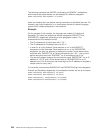
CHGOUTQ OUTQ(default) RMTSYS('1.2.3.4') RMTPRTQ('hpjet')
AUTOSTRWTR(1) CNNTYPE(*IP) TRANSFORM(*YES) MFRTYPMDL(*IBM42011)
DESTTYPE(*OTHER)
Firewalls:
Firewalls and other tools can mask or manipulate IP addresses to
appear other than the true Internet address. For that reason, the security of the
client IP address is only as good as the security of your TCP/IP network. For
information on firewall concepts and on an IBM firewall product for the AS/400, see
the
Getting Started with IBM Firewall for AS/400
, SC41-5424-02 book or go to
http://www.as400.ibm.com/firewall.
Exit Point Performance
The Telnet server response time for your initial session request will include any time
that it takes for the QIBM_QTG_DEVINIT user exit program to be called, executed
and returned. If your exit program is doing significant processing, the performance
impact may result in a longer wait before your session is established.
Once the Telnet program is established by way of a sign-on panel or other AS/400
panel, there is no performance impact. When this occurs, the user exit program is
no longer in the Telnet path. Established Telnet sessions experience no delays due
to the QIBM_QTG_DEVINIT user exit program.
There is no user-visible performance impact that is associated with disconnecting
the session. Disconnecting means that you end your terminal emulation session,
not that you sign-off and return to the sign-on panel. If you disconnect, then the
QIBM_QTG_DEVTERM user exit program is invoked, which will perform the
termination processing for your session. Users will not see this because it occurs
after the connection is broken.
Work Management
Key work management issues can be solved by using a Telnet exit program. These
issues include the capability to request device descriptions other than
QPADEVxxxx, opening up the door for work management control of interactive
virtual terminal jobs and routing those jobs to specific subsystems.
Subsystem routing and device name selection
It is recommended that no more than 300 users be serviced by any given
subsystem, for example, QBASE, QCMN, or QINTER. In the past, for Telnet, this
posed problems because workstation entries did not work due to the QPADEVxxxx
naming convention which meant that there was no way to subdivide the jobs easily.
Beginning with Version 4 Release 2, users can take advantage of better Telnet
virtual device names and configure their interactive subsystems to subdivide the
work, if necessary. This is done by using the
Add Work Station Entry
(ADDWSE)
command to specify which devices a subsystem should or should not allocate a
particular name of virtual terminal devices.
The following command has QINTER allocate all QPADEV* workstations, which
means that all such devices are routed to the QINTER subsystem:
ADDWSE SBSD(QINTER) WRKSTN(QPADEV*) AT(*SIGNON)
Chapter 6. Telnet Server 233


















